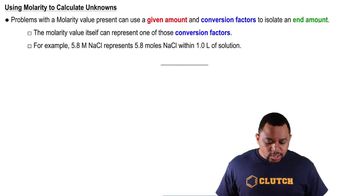Here are the essential concepts you must grasp in order to answer the question correctly.
Stoichiometry
Stoichiometry is the branch of chemistry that deals with the quantitative relationships between the reactants and products in a chemical reaction. It allows us to calculate the amounts of substances consumed and produced in a reaction based on balanced chemical equations. Understanding stoichiometry is essential for determining the molar concentration of solutions when given mass and volume data.
Recommended video:
Molarity
Molarity is a measure of concentration defined as the number of moles of solute per liter of solution. It is expressed in units of moles per liter (mol/L). To find the molarity of the Sn2+ solution, one must convert the mass of Fe2O3 into moles and relate it to the volume of the Sn2+ solution used in the reaction, using stoichiometric coefficients from the balanced equation.
Recommended video:
Redox Reactions
Redox reactions involve the transfer of electrons between two species, resulting in changes in oxidation states. In this context, the reaction between Sn2+ and Fe2O3 involves the reduction of Sn2+ and the oxidation of Fe3+. Understanding the principles of redox chemistry is crucial for determining how the reactants interact and for calculating the molar concentration of the Sn2+ solution based on the complete reaction with Fe2O3.
Recommended video:
Identifying Redox Reactions



